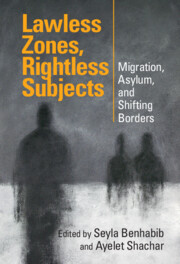Refine search
Actions for selected content:
4 results
3 - “Safe Third Country”
- from Part I - Territoriality and Rights Protection
-
-
- Book:
- Lawless Zones, Rightless Subjects
- Published online:
- 02 January 2025
- Print publication:
- 09 January 2025, pp 59-74
-
- Chapter
-
- You have access
- Open access
- HTML
- Export citation

Lawless Zones, Rightless Subjects
- Migration, Asylum, and Shifting Borders
-
- Published online:
- 02 January 2025
- Print publication:
- 09 January 2025
-
- Book
-
- You have access
- Open access
- Export citation
4 - The Stock Narrative of Becoming a Refugee
-
- Book:
- Judging Refugees
- Published online:
- 15 March 2024
- Print publication:
- 28 March 2024, pp 66-89
-
- Chapter
- Export citation
5 - Direct Challenges to Regional Containment Instruments
-
- Book:
- Protection from Refuge
- Published online:
- 17 March 2022
- Print publication:
- 24 March 2022, pp 112-148
-
- Chapter
- Export citation
